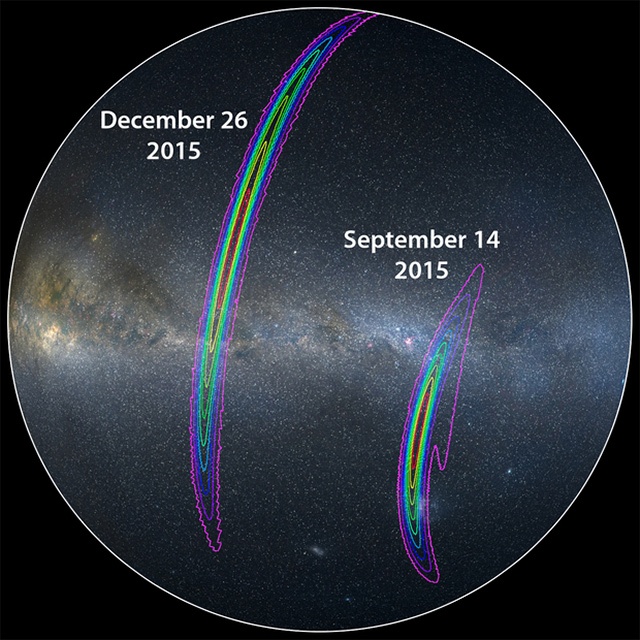Gravitational waves – the latest astonishing discovery
A good three months following their very first discovery, gravitational waves were detected for a second time by LIGO. The 2015 Christmas phenomenon was likely caused by a cataclysmic event: the collision of two black holes equalling the mass of several Suns. This latest result proves how gravitational wave detectors have genuinely opened a new window onto the universe.
The first reports that gravitational waves have been detected came out in February and caused quite a stir. The freshly turboed up laser arms of the LIGO twin-detectors were shaken by the robust energy waves emitted during the coalescence of two black holes. As emphasised during the February press conference, this event is not only an intriguing scientific event, or further experimental proof of Einstein’s general theory of relativity. Gravitational wave detectors opened an unprecedented window onto the universe, which we had been able to observe only with the help of electromagnetic signals (radio and light waves, X-rays and gamma radiation) reaching the Earth.
Window on the cosmos
Those who were initially sceptical regarding this impressive metaphor can now relax, as a new cataclysmic event has been detected through the new window opened up by LIGO. This time the scientists witnessed the collision of two black holes which were 14 and 8 times the mass of the Sun respectively. The event was detected on the second day of Christmas. The discovery was announced at 19:15 CEST on June 15 by LIGO. The observation was reported in an article in Physical Review Letters. The mass of the emerging black hole equals 21 times the mass of the Sun. Thus the 1 solar mass material that had “disappeared” during the collision was entirely emitted in the form of energy, i.e. as gravitational waves proving that the law of conservation of energy holds true in Einstein’s universe as well. The event was independently detected by both of the twin detectors of LIGO, located in Livingston, Louisiana and Hanford, Washington, USA – in a similar manner to the February event.
 LIGO Hanford and LIGO Livingston Source: Caltech/MIT/LIGO Lab
LIGO Hanford and LIGO Livingston Source: Caltech/MIT/LIGO LabHow does the gravitational wave detected in December and designated GW151226 compare to the gravitational wave designated GW150914 detected in September? This is well illustrated in the video made by Caltech LIGO laboratories:
 The approximate locations of the two gravitational-wave events detected so far on the southern hemisphere of the sky. The coloured lines represent different probabilities for the origin of the signal, with decreasing probability the further we move inwards. LIGO/Axel Mellinger
The approximate locations of the two gravitational-wave events detected so far on the southern hemisphere of the sky. The coloured lines represent different probabilities for the origin of the signal, with decreasing probability the further we move inwards. LIGO/Axel MellingerDelicacies from Einstein’s smorgasbord
“Four research groups of LIGO are searching for gravitational waves in the noisy data flow”, said Zsolt Frei, head of department at ELTE, Budapest and leader of the LIGO Group founded at the university in 2007. He is also the founder of MTA-ELTE Astrophysics Lendület (Momentum) Research Group. The groups are studying the properties of the following possible signal sources:
- Compact colliding objects – signals of this kind have been detected by LIGO. Compact objects include black holes, neutron stars and white dwarfs.
- Continuous waves – e.g. long lasting waves of a given frequency created by spinning neutron stars with a misaligned axis.
- Stochastic gravitational wave background.
- Other, abrupt waves not belonging to any of the above three categories. These include the gravitational wave signals of supernova explosions and starquakes.
A multitude of awards gravitate towards LIGO
For a scientific achievement, the laureates of the Breakthrough Prize are awarded the largest sum, namely 3 million USD. This approximately amounts to three Nobel Prizes. The award was founded by the leaders of technological mega companies and billionaires, including Sergey Brin (Google), Mark Zuckerberg (Facebook) and Yuri Milner physicist and venture capitalist. The award, which is often referred to as the “Nobel Prize of the 21st century” by journalists, is awarded for scientific breakthrough in three categories: life sciences, fundamental physics and mathematics. In 2016, the Breakthrough Prize in Fundamental Physics was awarded to Nobel Prize winning scientists researching neutrino oscillations; while in the previous year Nobel Prize winning astrophysicists received the award for discovering that the expansion of the universe is accelerating rather than slowing.
In 2016, the selection committee of the prize decided to present the prize for a second time. The three founders of LIGO, Ron Drever, Kip Thorne and Rai Weiss will equally share 1 million USD. The remaining 2 million USD will be equally distributed among the 1012 contributors of the experiment, the 1005 authors of the first scientific article reporting on the detection of gravitational waves and further seven physicists selected by the committee. Among the laureates of the Special Breakthrough Prize there are nine Hungarian physicists living and working in Hungary. Four of them practise their research in the LIGO Group of ELTE, Budapest while two of them are affiliated with the LIGO Group of Szeged University and three physicists work in the VIRGO Group of the Wigner Institute. Three Hungarian scientists living in the United States were also awarded.
Drever, Thorne and Weiss together with the whole LIGO Group also received the Gruber Cosmology Prize. The award, which will be presented to the scientists at the 21st International Conference on General Relativity and Gravitation in New York this summer, is worth 500 thousand USD. The conference is hosted by Hungarian scientists working for LIGO in New York. Zsolt Frei will also participate in the event, as ELTE, Budapest intends to win the right to organize this outstanding international conference in 2019, to commemorate the centenary of Loránd Eötvös’s death.
